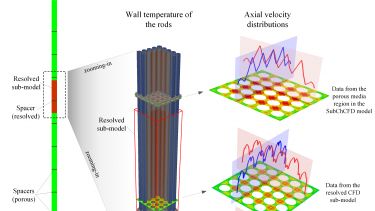Sub-channel CFD for Nuclear Reactors
Funded by BEIS Nuclear Innovation Program (NIP), 2017-2021, Grant references: TRN 1210/09/2016(3) and TRN 1659/10/2018. Core partner organisations: Frazer-Nash Consultancy (PI), University of Manchester, EDF, Westinghouse, STFC, University of Sheffield.
Researchers: Dr. Bo Liu, Prof. Shuisheng He
Collaborators: Dr. Charles Moulinec (STFC), Dr. Juan Uribe (EDF Energy)
Computational Fluid Dynamics (CFD) and High Performance Computing (HPC) have developed rapidly in the last decade, improving our understanding of complex physics and optimising component thermal hydraulics design. However, it is still not feasible to perform routine industrial thermal hydraulics calculations for sub-systems such as a single fuel channel, let alone a complete reactor core, using CFD due to the high computing cost. The current design calculations and safety case development still rely on the traditional 1-D system or sub-channel codes first developed in the 1960s and 1970s. Such methods become increasingly more inadequate for the high demands in safety and efficiency in the development of advanced reactor systems, where reliable predictions of 3-D phenomena and flow transients are of great importance. Consequently, a grand challenge is to develop a reliable and robust, low cost, highly flexible, full 3-D numerical tool for routine engineering calculations taking advantage of the modern advancement in CFD.
Our solution is Sub-Channel CFD (SubChCFD), a ‘smart’ mix of CFD and sub-channel methodologies, which takes the advantages of both approaches and, equally importantly, circumvents their drawbacks. Like a sub-channel code, SubChCFD can be calibrated, making use of existing engineering data, and can be validated and potentially licenced for specific reactor component designs. The method is highly flexible and can be coupled directly with resolved CFD to provide locally high resolution predictions of the flow and porous medium approach to capture the integral effects of complex structures.
Up to now, the baseline model has been developed [1], followed by its coupling with resolved CFD [2], and with porous model [3]. Currently, demonstration of its use in simulating a full channel is undergoing.
Publications
- Bo Liu, Shuisheng He, Charles Moulinec & Juan Uribe. Sub-Channel CFD for Nuclear Fuel Bundles, Nuclear Engineering and Design, 2019, 355: 110318
- Bo Liu, Shuisheng He, Charles Moulinec & Juan Uribe. A Coupling Approach between Resolved CFD and a Coarse-grid Sub-channel CFD, Nuclear Engineering and Design, 2021
- Bo Liu, Shuisheng He, Charles Moulinec & Juan Uribe. Coupled Porous Media Approaches in Sub-channel CFD, Nuclear Engineering and Design, 2021

